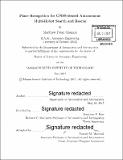| dc.contributor.advisor | Jonathan P. How. | en_US |
| dc.contributor.author | Giamou, Matthew Peter | en_US |
| dc.contributor.other | Massachusetts Institute of Technology. Department of Aeronautics and Astronautics. | en_US |
| dc.date.accessioned | 2017-12-05T19:12:07Z | |
| dc.date.available | 2017-12-05T19:12:07Z | |
| dc.date.copyright | 2017 | en_US |
| dc.date.issued | 2017 | en_US |
| dc.identifier.uri | http://hdl.handle.net/1721.1/112422 | |
| dc.description | Thesis: S.M., Massachusetts Institute of Technology, Department of Aeronautics and Astronautics, 2017. | en_US |
| dc.description | Cataloged from PDF version of thesis. | en_US |
| dc.description | Includes bibliographical references (pages 77-85). | en_US |
| dc.description.abstract | Teams of agile unmanned aerial vehicles (UAVs) possess great potential for search and rescue missions requiring a rapid response over a large region of interest. With proper coordination, these robotic vehicles can leverage affordable hardware to efficiently search a remote region or disaster site for lost or injured people. However, effective search coordination requires that the robots successfully fuse information from their environment into an accurate and consistent localization and mapping scheme in order to ensure the entire region of interest is explored. This requires that the robots communicate observations of their environment or other robots to produce inter-robot trajectory and map constraints. The difficulty of this task is exacerbated in areas without Global Navigation Satellite System (GNSS) coverage, as absolute pose measurements are unavailable. This thesis explores solutions to the place recognition problem for UAVs under a dense forest canopy. The perception and communication challenges in a forest environment are explored for a multi-UAV system. A survey of existing place-recognition and multi-agent simultaneous localization and mapping (SLAM) systems is conducted and several candidate approaches are discussed, and a multi-agent pose-SLAM formulation is introduced as a practical framework. A state-of-the-art laser-based place recognition system is implemented and augmented with a Dirichlet process means (DP-means) clustering for stable feature selection. Finally, recent results describing some graph theoretic properties of SLAM problems are used in a resource-constrained SLAM framework. Experimental data collected from Middlesex Fells Reservation is used to validate the algorithms presented. | en_US |
| dc.description.statementofresponsibility | by Matthew Peter Giamou. | en_US |
| dc.format.extent | 85 pages | en_US |
| dc.language.iso | eng | en_US |
| dc.publisher | Massachusetts Institute of Technology | en_US |
| dc.rights | MIT theses are protected by copyright. They may be viewed, downloaded, or printed from this source but further reproduction or distribution in any format is prohibited without written permission. | en_US |
| dc.rights.uri | http://dspace.mit.edu/handle/1721.1/7582 | en_US |
| dc.subject | Aeronautics and Astronautics. | en_US |
| dc.title | Place recognition for GNSS-denied autonomous multi-robot search and rescue | en_US |
| dc.title.alternative | Place recognition for Global Navigation Satellite System-denied autonomous multi-robot search and rescue | en_US |
| dc.type | Thesis | en_US |
| dc.description.degree | S.M. | en_US |
| dc.contributor.department | Massachusetts Institute of Technology. Department of Aeronautics and Astronautics | |
| dc.identifier.oclc | 1008736369 | en_US |
